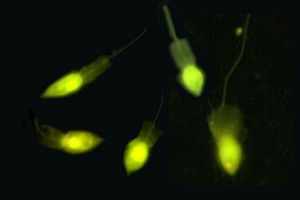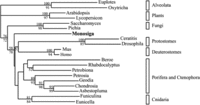Choanoflagellata: Difference between revisions
| Line 36: | Line 36: | ||
Choanoflagellates are bacteriovores whose role is to consume bacteria and release inorganic nutrients back into the water. These organisms are found worldwide in all aquatic habitats, both freshwater and marine. The type of habitat depends on the cell covering structure, which must provide the cell with proper protection and feeding abilities. | Choanoflagellates are bacteriovores whose role is to consume bacteria and release inorganic nutrients back into the water. These organisms are found worldwide in all aquatic habitats, both freshwater and marine. The type of habitat depends on the cell covering structure, which must provide the cell with proper protection and feeding abilities. | ||
[[Image:choanoflagellates.gif|thumb| | [[Image:choanoflagellates.gif|thumb|450px|center|Morphological similarities between choanoflagellates and sponges. Image from [http://users.rcn.com/jkimball.ma.ultranet/BiologyPages/P/Protists.html Kimball's Biology Pages.]]] | ||
==References== | ==References== | ||
Revision as of 18:10, 15 June 2006
|
NCBI: |

Classification
Higher order taxa:
Eukaryota; Fungi/Metazoa group
Species:
Proterospongia, Monosiga ovata, Salpingoeca
Description and Significance
Choanoflagellates are small single-celled protists that live in freshwater and marine environments. They have one flagellum, which enables them to eat and move. Around this flagellum is a collar-like ring of microvilli (slender fingerlike projections) and it is from this structure that the name "choanoflagellate" (collar-flagellate) is derived. The flagellum beats water through the microvilli, which filters out bacteria and tiny food particles. Under everything but the most powerful microscope the microvilli look like a single unit. Choanoflagellates either use the flagellum for locomotion or are rooted to the substrate by a thin stalk. While the choanoflagellates' history is not completely known, morphological evidence has shown that they may be the closest living relatives of the sponges, the most primitive animals. Choanoflagellates are nearly identical to the collar cells (choanocytes) of sponges, which also act as filters of bacteria and food particles. One colonial species of Choanoflagellata in particular, Proterospongia, demonstrates some characteristics which may have been shared by some of the sponge's ancestors. The link between choanoflagellates and sponges has long been a subject of debate among taxonomists and other scientists, and raises questions whose answers greatly impact our understanding of evolution.
Genome Structure

In order to test some of these theories on the ancestry of Metazoa (animals), scientists have mapped out the mitochondrial genomes of several eukaryotes from all branches of the phylogenic (evolutionary) tree. A report from the University of Reading states that the completed sequence of the hsp70 gene from the choanoflagellate species Monosiga ovata is remarkably similar to many of the animal hsp70 genes which were also mapped, conclusive genetic evidence that animals are probably derived from the choanoflagellates. Because only one species of choanoflagellata was sequenced, however, it is possible that some choanoflagellates are more closely related to animals while some are more closely related to fungi. For analysis by Elizabeth A. Snell and colleagues, click here.
Cell Structure and Metabolism


With their characteristic collar surrounding the flagella, choanoflagellate cells are easy to recognize. They are 5-10 microns long, and colorless. The material which covers the cells, however, comes in many different forms, such as stalks, long vases, or cups depending on the species. The cell covering is a vital part of the cell, helping to affix it when the cell needs to eat. One of the more interesting forms of cell covering is the lorica, thin strands which form a basket shape. This basket helps create drag to slow the cell down or to prevent movement altogether, and probably played a necessary role in allowing choanoflagellates' habitats to extend to the open ocean.
Choanoflagellates reproduce asexually through binary division; sexual reproduction methods are not known.
Ecology
Choanoflagellates are bacteriovores whose role is to consume bacteria and release inorganic nutrients back into the water. These organisms are found worldwide in all aquatic habitats, both freshwater and marine. The type of habitat depends on the cell covering structure, which must provide the cell with proper protection and feeding abilities.

References
Molecular Microbial Ecology, Woods Hole Oceanographic Institution

